Open Bite Treatment with Combined Aligners and Myofunctional Appliances: A Case Report
Abstract
:1. Introduction
2. Case Description and Results
2.1. Diagnosis and Etiology
2.2. Treatment Objectives
2.3. Treatment Alternatives
- (1)
- Orthognathic surgery was presented as the ideal treatment option to improve the profile aesthetics, to correct the mandibular laterodeviation, and to resolve the gummy smile.
- (2)
- Alternatively, skeletal maxillary expansion was proposed through surgically-assisted or miniscrew-assisted rapid palatal expansion—with an explanation of the pros and cons of both procedures, as well as the difference in scientific evidence supporting both options—followed by fixed appliance treatment with asymmetric elastics, with the purpose of correcting the mandibular laterodeviation, at least from a dentoalveolar point of view.
- (3)
- To correct the patient’s malocclusion while embracing the patient’s request to have an aesthetic treatment, a lingual fixed appliance was proposed.
- (4)
- The last treatment option proposed to the patient was orthodontic therapy with clear aligners and elastodontic devices (Nuvola® OP System), combined with miniscrews and a transpalatal arch (TPA) to allow controlled intrusion of the posterior molars.
2.4. Treatment Progress
2.5. Treatment Results
3. Discussion
4. Conclusions
Author Contributions
Funding
Institutional Review Board Statement
Informed Consent Statement
Data Availability Statement
Conflicts of Interest
References
- Beane, R.A.; Reimann, G.; Phillips, C.; Tulloch, C. A cephalometric comparison of black open-bite subjects and black normal. Angle Orthod. 2003, 73, 294–300. [Google Scholar] [CrossRef]
- Cangialosi, T. Skeletal morphologic features of anterior open bite. Am. J. Orthod. 1984, 85, 28–36. [Google Scholar] [CrossRef] [PubMed]
- Asiry, M.A.; AlShahrani, I. Prevalence of malocclusion among school children of Southern Saudi Arabia. J. Orthod. Sci. 2019, 8, 2. [Google Scholar] [CrossRef]
- Lentini-Oliveira, D.A.; Carvalho, F.R.; Rodrigues, C.G.; Ye, Q.; Hu, R.; Minami-Sugaya, H.; Carvalho, L.B.; Prado, L.B.; Prado, G.F. Orthodontic and orthopaedic treatment for anterior open bite in children. Cochrane Database Syst. Rev. 2014, 2014, CD005515. [Google Scholar] [CrossRef] [PubMed]
- Cozza, P.; Baccetti, T.; Franchi, L.; Mucedero, M.; Polimeni, A. Sucking habits and facial hyperdivergency as risk factors for anterior open bite in the mixed dentition. Am. J. Orthod. Dentofac. Orthop. 2005, 128, 517–519. [Google Scholar] [CrossRef] [PubMed]
- Xun, C.; Zeng, X.; Wang, X. Microscrew anchorage in skeletal anterior open-bite treatment. Angle Orthod. 2007, 77, 47–56. [Google Scholar] [CrossRef] [PubMed]
- Rizzatto, S.; Allgayer, S.; Menezes, L.; Lima, E. Tratamento da deformidade maxilar decorrente de hábitos deletérios: Relato de caso. Rev. Clin. Ortod. Dent. Press. 2011, 10, 106–115. [Google Scholar]
- Cozza, P.; Baccetti, T.; Franchi, L.; Mucedero, M. Comparison of 2 early treatment protocols for open-bite malocclusions. Am. J. Orthod. Dentofac. Orthop. 2007, 132, 743–747. [Google Scholar] [CrossRef]
- Bianchi, J.; Pinto, A.d.S.; Ignácio, J.; Obelenis Ryan, D.P.; Gonçalves, J.R. Effect of temporomandibular joint articular disc repositioning on anterior open-bite malocclusion: An orthodontic-surgical approach. Am. J. Orthod. Dentofac. Orthop. 2017, 152, 848–858. [Google Scholar] [CrossRef]
- Buschang, P.H.; Sankey, W.; English, J.P. Early treatment of hyperdivergent open-bite malocclusions. Semin. Orthod. 2002, 8, 130–140. [Google Scholar] [CrossRef]
- Bueno Medeiros, R.; Cardoso de Araújo, L.F.; Mucha, J.N.; Trindade Motta, A. Stability of open-bite treatment in adult patients: A systematic review. J. World Fed. Orthod. 2012, 1, 97–101. [Google Scholar] [CrossRef]
- Sherwood, K.H.; Burch, J.G.; Thompson, W.J. Closing anterior open bites by intruding molars with titanium miniplate anchorage. Am. J. Orthod. Dentofac. Orthop. 2002, 122, 593–600. [Google Scholar] [CrossRef] [PubMed]
- Erverdi, N.; Usumez, S.; Solak, A. New generation open-bite treatment with zygomatic anchorage. Angle Orthod. 2006, 76, 519–526. [Google Scholar] [CrossRef]
- Park, H.S.; Kwon, O.W.; Sung, J.H. Nonextraction treatment of an open bite with microscrew implant anchorage. Am. J. Orthod. Dentofac. Orthop. 2006, 130, 391–402. [Google Scholar] [CrossRef]
- Alsafadi, A.S.; Alabdullah, M.M.; Saltaji, H.; Abdo, A.; Youssef, M. Effect of molar intrusion with temporary anchorage devices in patients with anterior open bite: A systematic review. Prog. Orthod. 2016, 17, 1–13. [Google Scholar] [CrossRef] [PubMed]
- Giancotti, A.; Garino, F.; Mampieri, G. Use of clear aligners in open bite cases: An unexpected treatment option. J. Orthod. 2017, 44, 114–125. [Google Scholar] [CrossRef]
- Harris, K.; Ojima, K.; Dan, C.; Upadhyay, M.; Alshehri, A.; Kuo, C.-L.; Mu, J.; Uribe, F.; Nanda, R. Evaluation of open bite closure using clear aligners: A retrospective study. Prog. Orthod. 2020, 21, 23. [Google Scholar] [CrossRef] [PubMed]
- Robertson, L.; Kaur, H.; Fagundes, N.C.F.; Romanyk, D.; Major, P.; Flores Mir, C. Effectiveness of clear aligner therapy for orthodontic treatment: A systematic review. Orthod. Craniofacial Res. 2020, 23, 133–142. [Google Scholar] [CrossRef] [PubMed]
- Miller, J.R. Treatment of a twice-relapsed anterior open bite using temporary anchorage devices, myofunctional therapy, and fixed passive self-ligating appliances. Am. J. Orthod. Dentofac. Orthop. 2020, 157, 832–842. [Google Scholar] [CrossRef] [PubMed]
- Tepedino, M.; Cattaneo, P.M.; Niu, X.; Cornelis, M.A. Interradicular sites and cortical bone thickness for miniscrew insertion: A systematic review with meta-analysis. Am. J. Orthod. Dentofac. Orthop. 2020, 158, 783–798.e20. [Google Scholar] [CrossRef]
- Tepedino, M.; Cornelis, M.A.; Chimenti, C.; Cattaneo, P.M. Correlation between tooth size-arch length discrepancy and interradicular distances measured on CBCT and panoramic radiograph: An evaluation for miniscrew insertion. Dent. Press J. Orthod. 2018, 23, 39.e1–39.e13. [Google Scholar] [CrossRef] [PubMed]
- d’Apuzzo, F.; Perillo, L.; Carrico, C.K.; Castroflorio, T.; Grassia, V.; Lindauer, S.J.; Shroff, B. Clear aligner treatment: Different perspectives between orthodontists and general dentists. Prog Orthod. 2019, 20, 10. [Google Scholar] [CrossRef] [PubMed]
- Ramos-Jorge, J.; Motta, T.; Marques, L.S.; Paiva, S.M.; Ramos-Jorge, M.L. Association between anterior open bite and impact on quality of life of preschool children. Braz. Oral Res. 2015, 29, 1–7. [Google Scholar] [CrossRef]
- Baek, M.S.; Choi, Y.J.; Yu, H.S.; Lee, K.J.; Kwak, J.; Park, Y.C. Long-term stability of anterior open-bite treatment by intrusion of maxillary posterior teeth. Am. J. Orthod. Dentofac. Orthop. 2010, 138, 396.e1–396.e9. [Google Scholar] [CrossRef]
- Azaripour, A.; Weusmann, J.; Mahmoodi, B.; Peppas, D.; Gerhold-Ay, A.; Van Noorden, C.J.F.; Willershausen, B. Braces versus Invisalign®: Gingival parameters and patients’ satisfaction during treatment: A cross-sectional study. BMC Oral Health 2015, 15, 69. [Google Scholar] [CrossRef]
- Verena Nedwed, R.-R.M. Motivation, Acceptance and Problems of Invisalign® Patients. J. Orofac. Orthop. 2005, 66, 162–173. [Google Scholar] [CrossRef]
- Shalish, M.; Cooper-kazaz, R.; Ivgi, I.; Canetti, L.; Tsur, B.; Bachar, E.; Chaushu, S. Adult patients’ a djustability to o rthodontic a ppliances. Part I: A comparison between Labial, Lingual, and InvisalignTM. Eur. J. Orthod. 2012, 34, 724–730. [Google Scholar] [CrossRef]
- Ke, Y.; Zhu, Y.; Zhu, M. A comparison of treatment effectiveness between clear aligner and fixed appliance therapies. BMC Oral Health 2019, 19, 24. [Google Scholar] [CrossRef]
- Tepedino, M.; Paoloni, V.; Cozza, P.; Chimenti, C. Movement of anterior teeth using clear aligners: A three-dimensional, retrospective evaluation. Prog. Orthod. 2018, 19, 9. [Google Scholar] [CrossRef]
- Yassir, Y.A.; Nabbat, S.A.; McIntyre, G.T.; Bearn, D.R. Clinical effectiveness of clear aligner treatment compared to fixed appliance treatment: An overview of systematic reviews. Clin. Oral Investig. 2022, 26, 2353–2370. [Google Scholar] [CrossRef]
- Kravitz, N.D.; Kusnoto, B.; BeGole, E.; Obrez, A.; Agran, B. How well does Invisalign work? A prospective clinical study evaluating the efficacy of tooth movement with Invisalign. Am. J. Orthod. Dentofac. Orthop. 2009, 135, 27–35. [Google Scholar] [CrossRef]
- De Felice, M.E.; Nucci, L.; Fiori, A.; Flores-Mir, C.; Perillo, L.; Grassia, V. Accuracy of interproximal enamel reduction during clear aligner treatment. J. Oral. Biol. Craniofacial Res. 2019, 21, 360–362. [Google Scholar] [CrossRef] [PubMed]
- Kuroda, S.; Sakai, Y.; Tamamura, N.; Deguchi, T.; Takano-Yamamoto, T. Treatment of severe anterior open bite with skeletal anchorage in adults: Comparison with orthognathic surgery outcomes. Am. J. Orthod. Dentofac. Orthop. 2007, 132, 599–605. [Google Scholar] [CrossRef] [PubMed]
- Zuroff, J.P.; Chen, S.H.; Shapiro, P.A.; Little, R.M.; Joondeph, D.R.; Huang, G.J. Orthodontic treatment of anterior open-bite malocclusion: Stability 10 years postretention. Am. J. Orthod. Dentofac. Orthop. 2010, 137, 302.e1–302.e8. [Google Scholar] [CrossRef]
- Ngan, P.; Fields, H.W. Open bite: A review of etiology and management. Am. Acad. Pediatr. Dent. 1997, 19, 91–98. [Google Scholar]
- González Espinosa, D.; de Oliveira Moreira, P.E.; da Sousa, A.S.; Flores-Mir, C.; Normando, D. Stability of anterior open bite treatment with molar intrusion using skeletal anchorage: A systematic review and meta-analysis. Prog. Orthod. 2020, 21, 2–14. [Google Scholar] [CrossRef]
- Dixit, U.; Shetty, R. Comparison of soft-tissue, dental, and skeletal characteristics in children with and without tongue thrusting habit. Contemp. Clin. Dent. 2013, 4, 2–6. [Google Scholar] [CrossRef] [PubMed]
- Uchida, M.; Yamaguchi, K.; Nagano, S.; Ichida, T. Daily clenching exercise, enhances the occlusal contact. Soc. Jpn. Orthod. 2005, 64, 29–37. [Google Scholar]
- Kiliaridis, S.; Tzakis, M.G.; Carlsson, G.E. Effects of fatigue and chewing training on maximal bite force and endurance. Am. J. Orthod. Dentofac. Orthop. 1995, 107, 372–378. [Google Scholar] [CrossRef]
- Bakke, M.; Michler, L.; Han, K.; Möller, E. Clinical significance of isometric bite force versus electrical activity in temporal and masseter muscles. Eur. J. Oral. Sci. 1989, 97, 539–551. [Google Scholar] [CrossRef]
- Mozzanica, F.; Pizzorni, N.; Scarponi, L.; Crimi, G.; Schindler, A. Impact of Oral Myofunctional Therapy on Orofacial Myofunctional Status and Tongue Strength in Patients with Tongue Thrust. Folia Phoniatr. Logop. 2021, 73, 413–421. [Google Scholar] [CrossRef] [PubMed]
- Van Dyck, C.; Dekeyser, A.; Vantricht, E.; Manders, E.; Goeleven, A.; Fieuws, S.; Willems, G. The effect of orofacial myofunctional treatment in children with anterior open bite and tongue dysfunction: A pilot study. Eur. J. Orthod. 2016, 38, 227–234. [Google Scholar] [CrossRef] [PubMed]
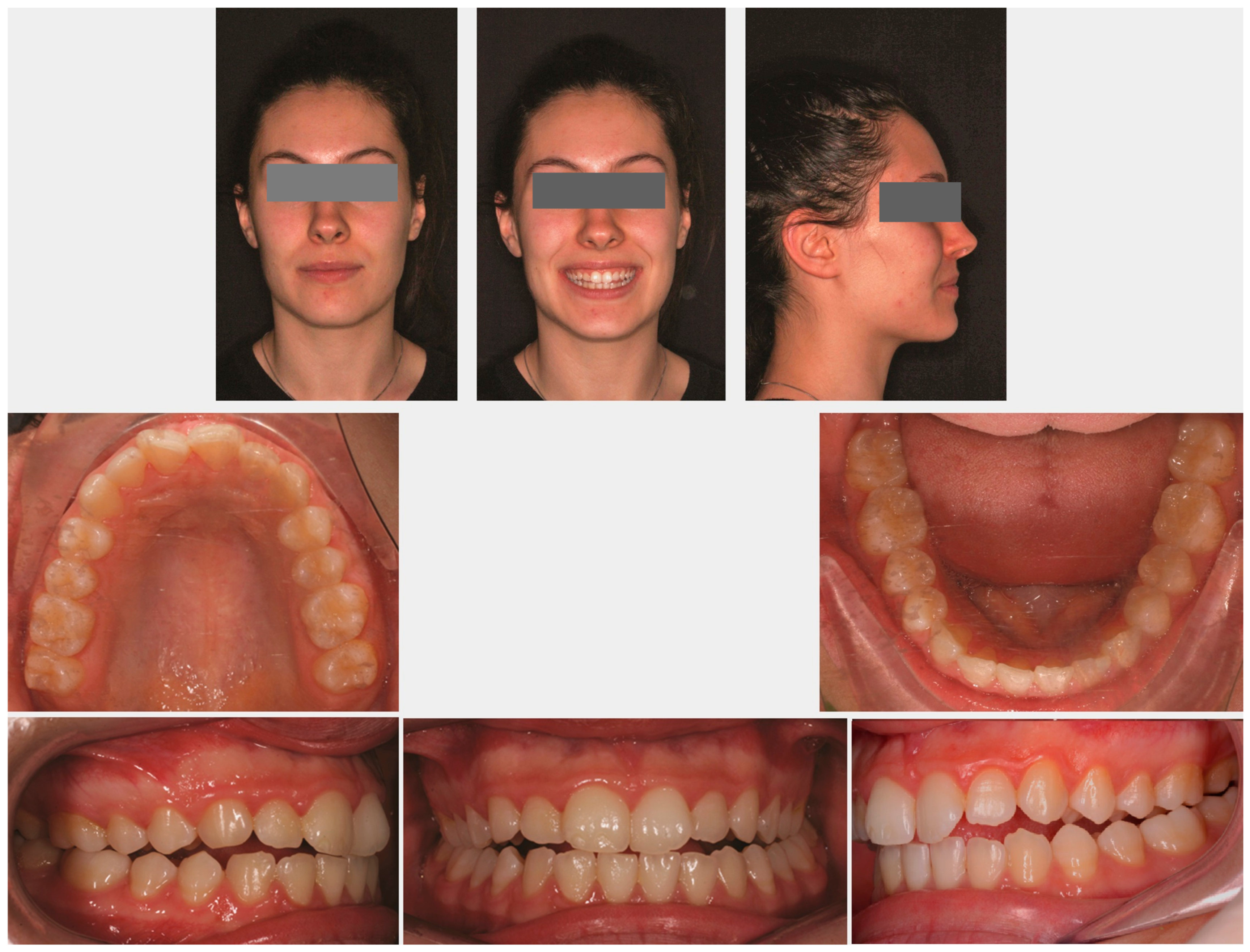
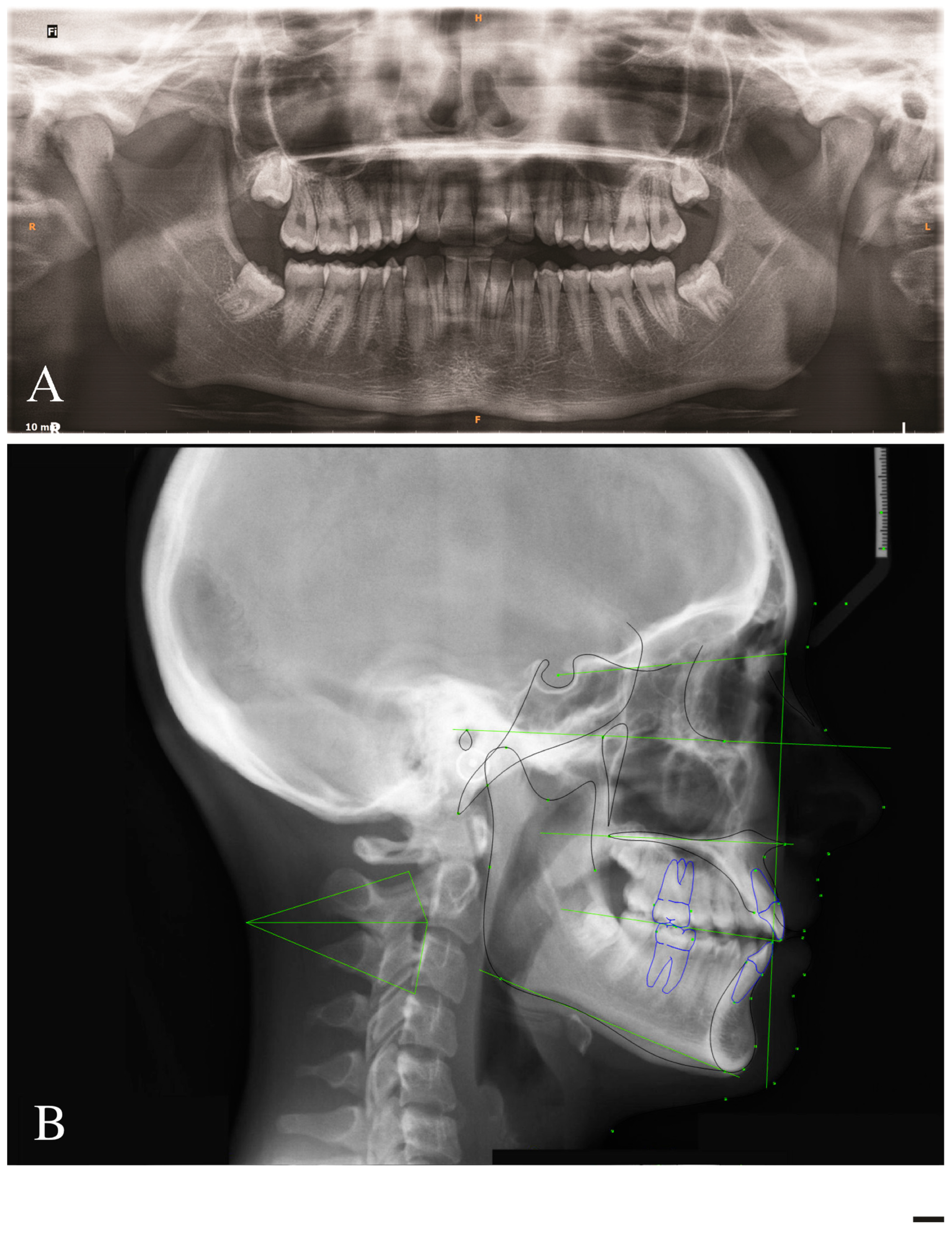
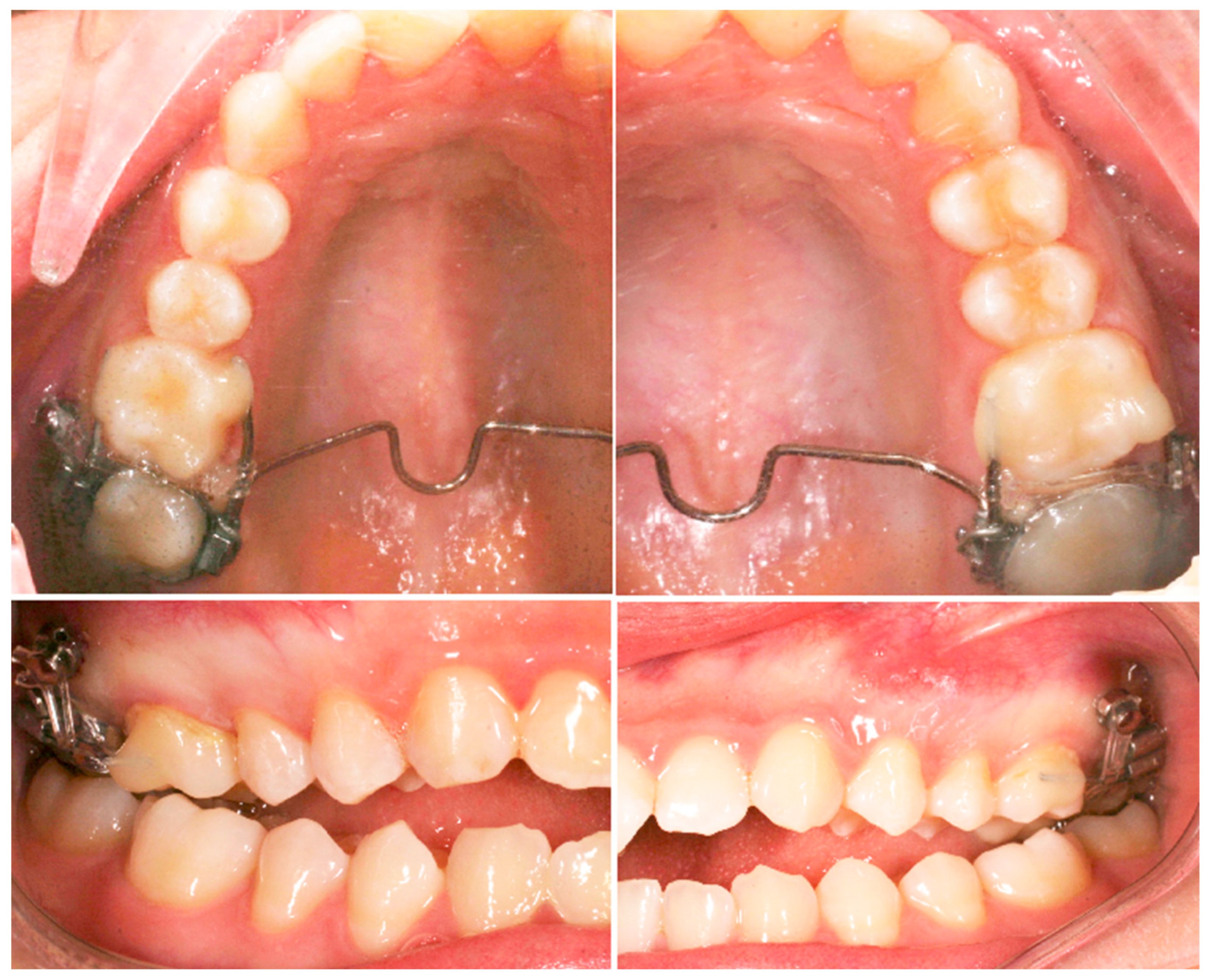
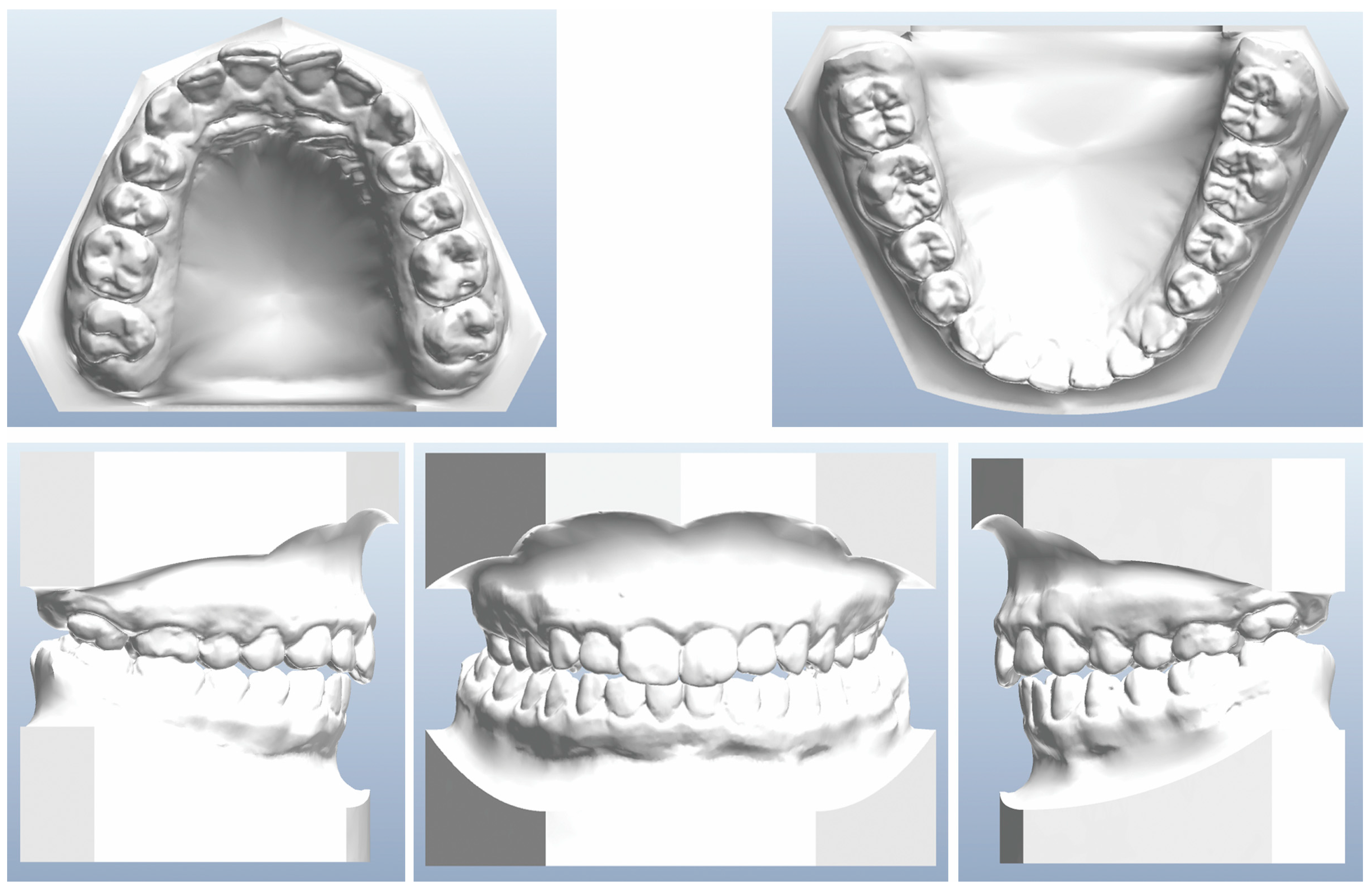
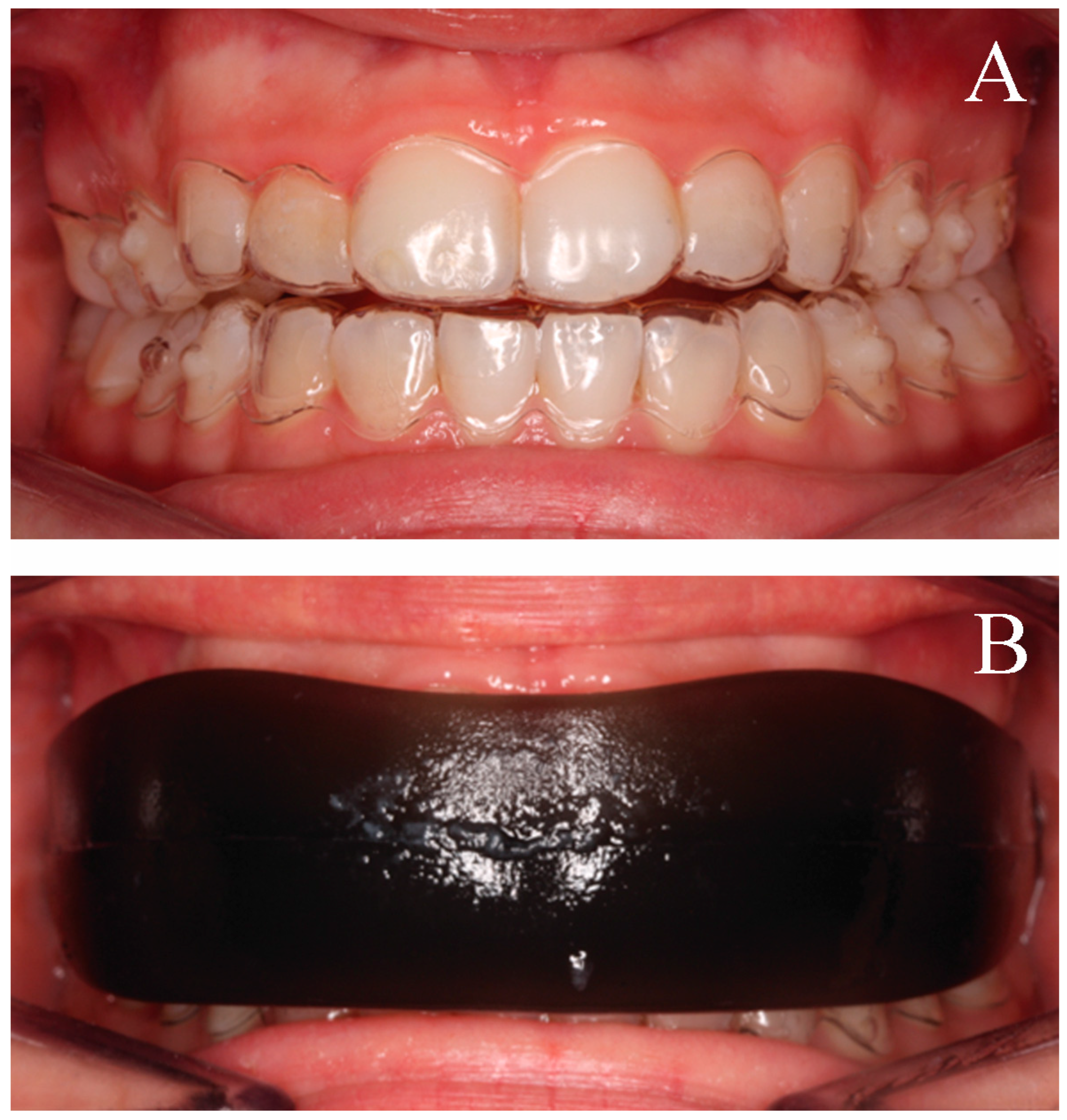

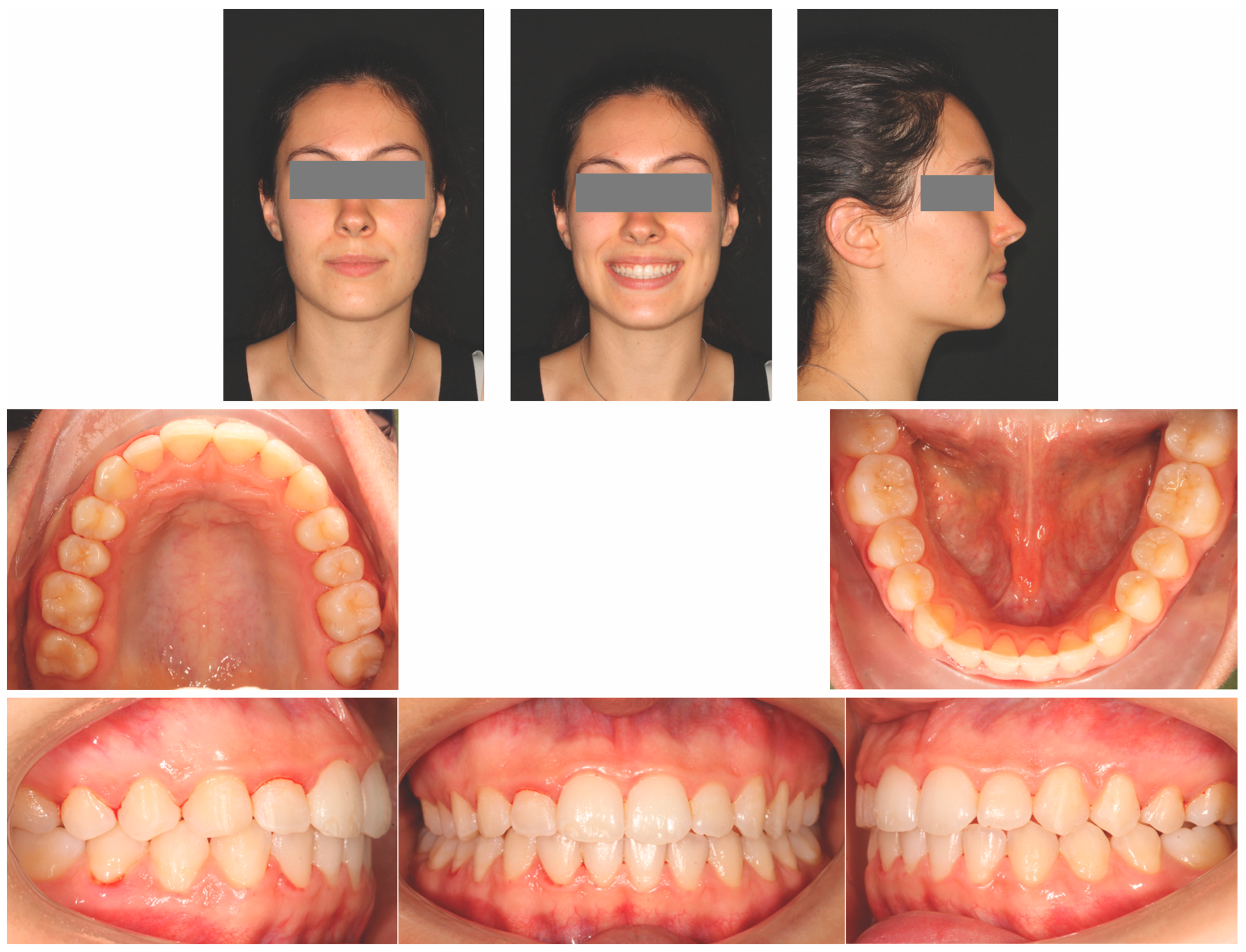
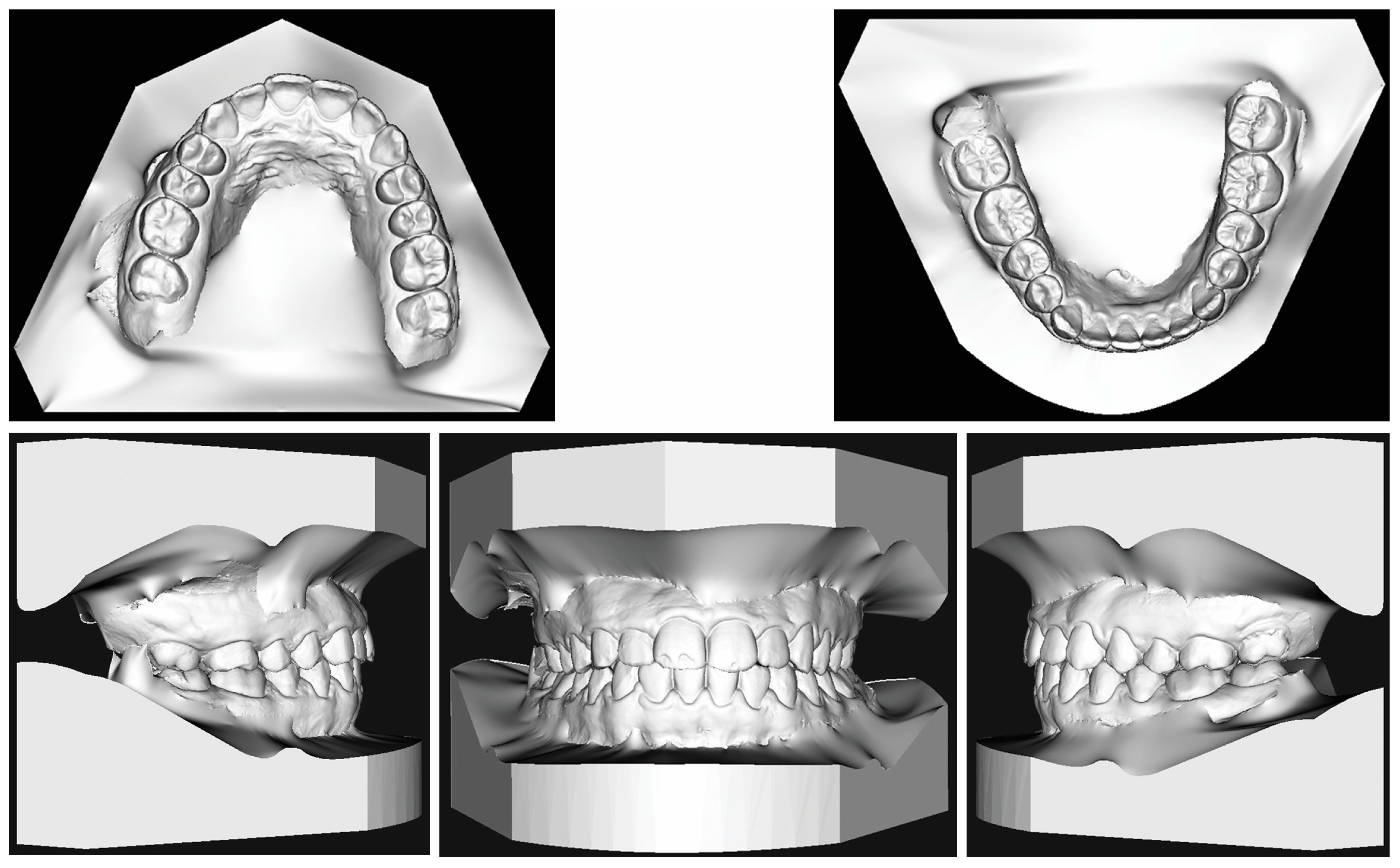
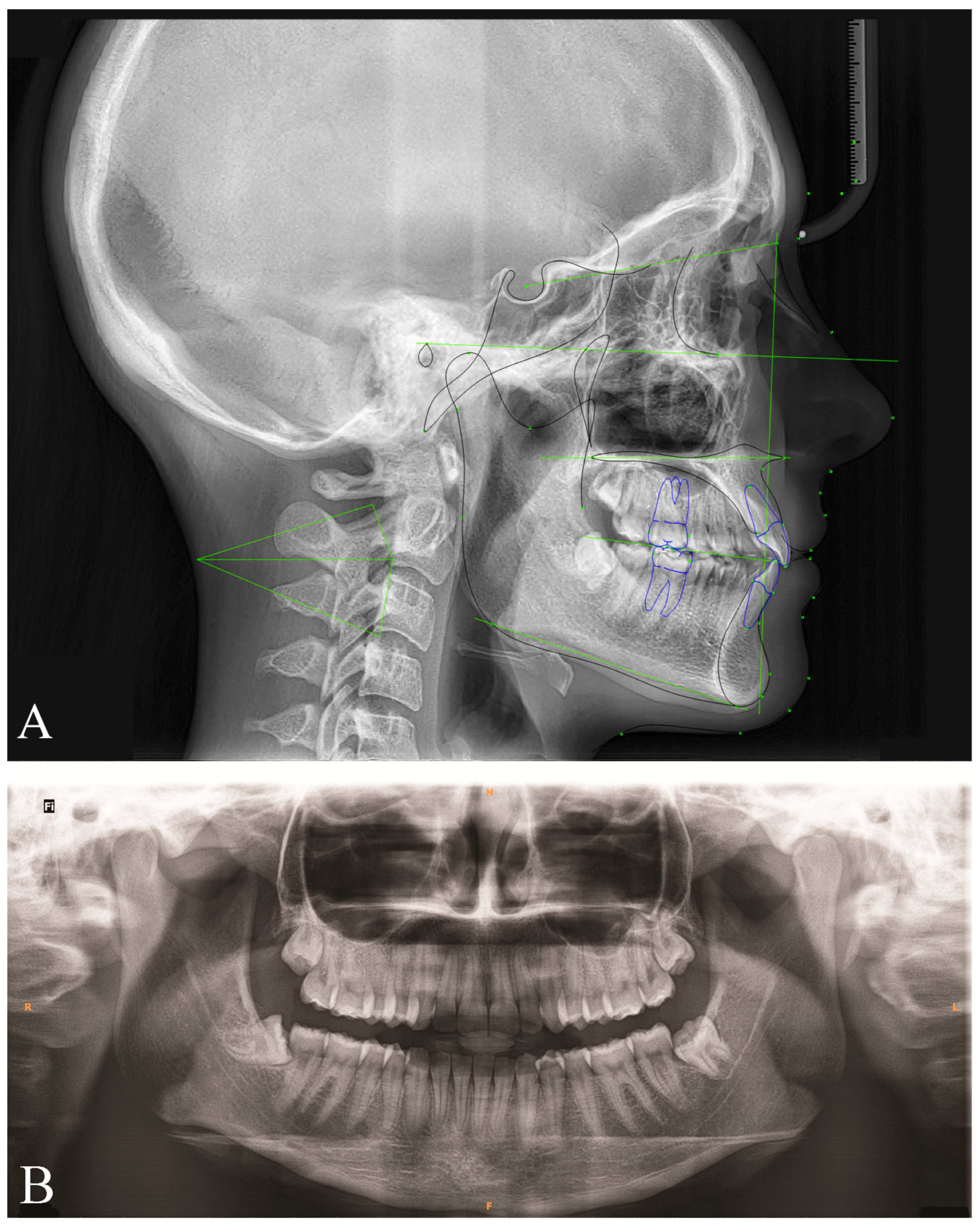

| Measurement | Norm | Pre-Treatment | Post-Treatment | Difference | |
|---|---|---|---|---|---|
| Mean | SD | ||||
| SNA (°) | 82.0 | 3.5 | 78.7 | 79.4 | 0.7 |
| SNB (°) | 80.0 | 3.0 | 78.0 | 79.4 | 1.4 |
| ANB (°) | 2.0 | 2.4 | 0.7 | 0.0 | −0.7 |
| Wits Appraisal (mm) | 0.0 | 1.0 | −1.0 | −2.2 | 1.2 |
| FMA (°) | 26.0 | 5.0 | 23.9 | 21.9 | −2.0 |
| U1-Apo (mm) | 6.0 | 2.2 | 4.9 | 5.0 | 0.1 |
| L1-Apo (mm) | 2.0 | 2.3 | 2.0 | 2.5 | 0.5 |
| U1-PP (°) | 110.0 | 5.0 | 117.2 | 112.4 | −4.8 |
Disclaimer/Publisher’s Note: The statements, opinions and data contained in all publications are solely those of the individual author(s) and contributor(s) and not of MDPI and/or the editor(s). MDPI and/or the editor(s) disclaim responsibility for any injury to people or property resulting from any ideas, methods, instructions or products referred to in the content. |
© 2023 by the authors. Licensee MDPI, Basel, Switzerland. This article is an open access article distributed under the terms and conditions of the Creative Commons Attribution (CC BY) license (https://creativecommons.org/licenses/by/4.0/).
Share and Cite
Tepedino, M.; Iancu Potrubacz, M.; Esposito, R.; Staderini, E.; Ciavarella, D. Open Bite Treatment with Combined Aligners and Myofunctional Appliances: A Case Report. Appl. Sci. 2023, 13, 11696. https://doi.org/10.3390/app132111696
Tepedino M, Iancu Potrubacz M, Esposito R, Staderini E, Ciavarella D. Open Bite Treatment with Combined Aligners and Myofunctional Appliances: A Case Report. Applied Sciences. 2023; 13(21):11696. https://doi.org/10.3390/app132111696
Chicago/Turabian StyleTepedino, Michele, Maciej Iancu Potrubacz, Rosa Esposito, Edoardo Staderini, and Domenico Ciavarella. 2023. "Open Bite Treatment with Combined Aligners and Myofunctional Appliances: A Case Report" Applied Sciences 13, no. 21: 11696. https://doi.org/10.3390/app132111696
APA StyleTepedino, M., Iancu Potrubacz, M., Esposito, R., Staderini, E., & Ciavarella, D. (2023). Open Bite Treatment with Combined Aligners and Myofunctional Appliances: A Case Report. Applied Sciences, 13(21), 11696. https://doi.org/10.3390/app132111696










